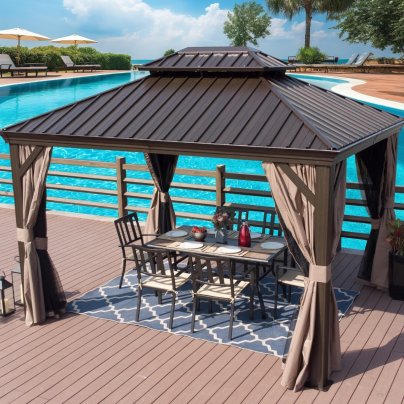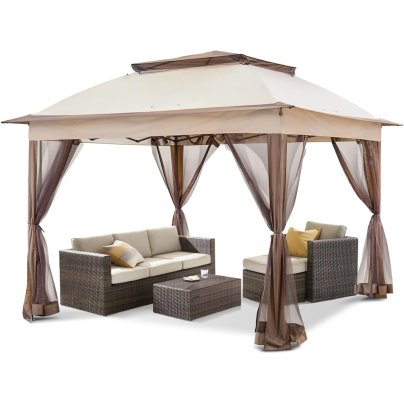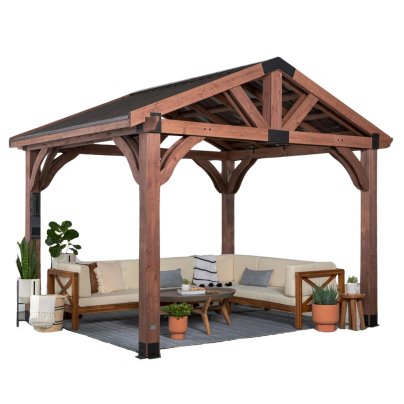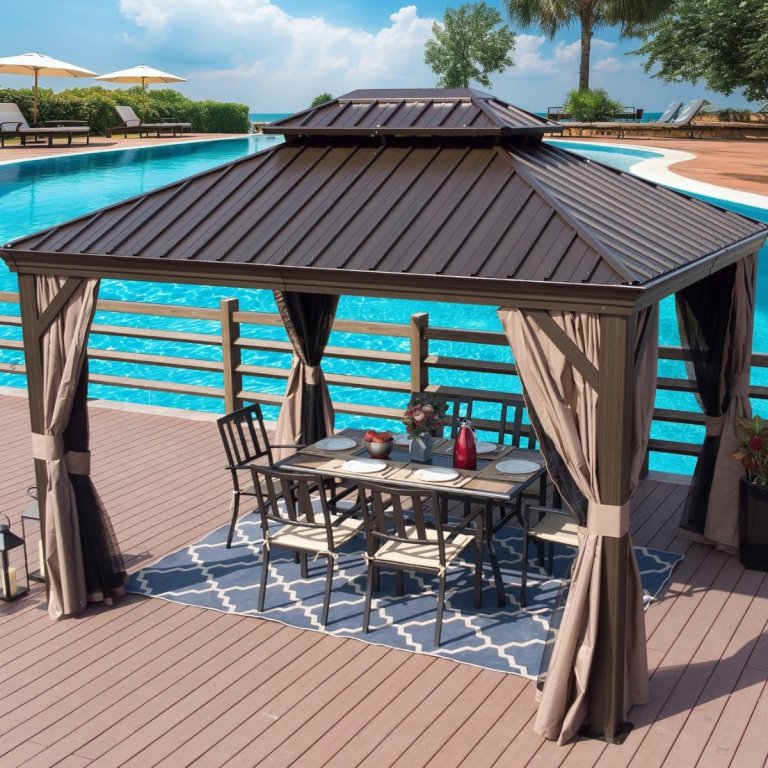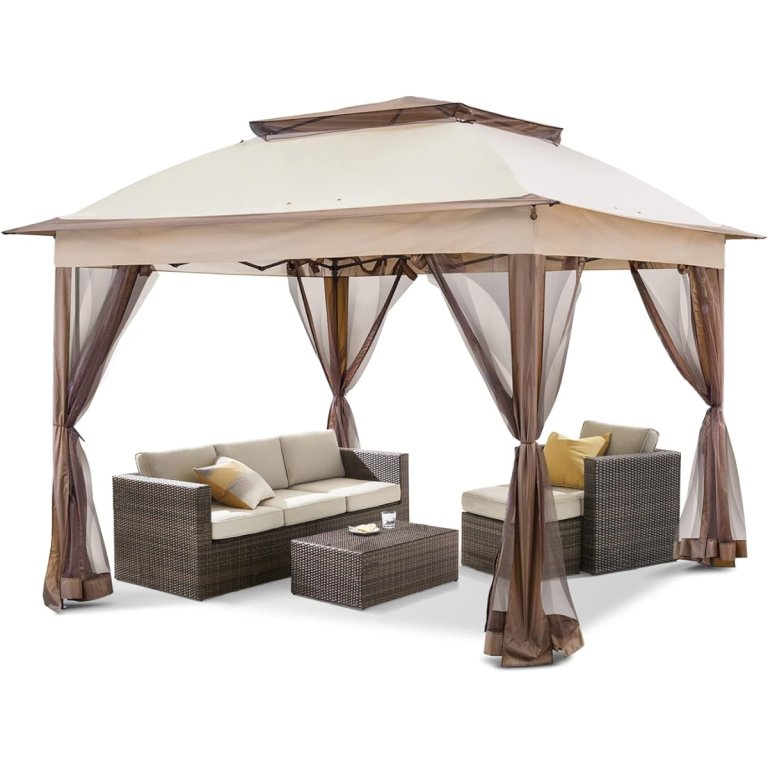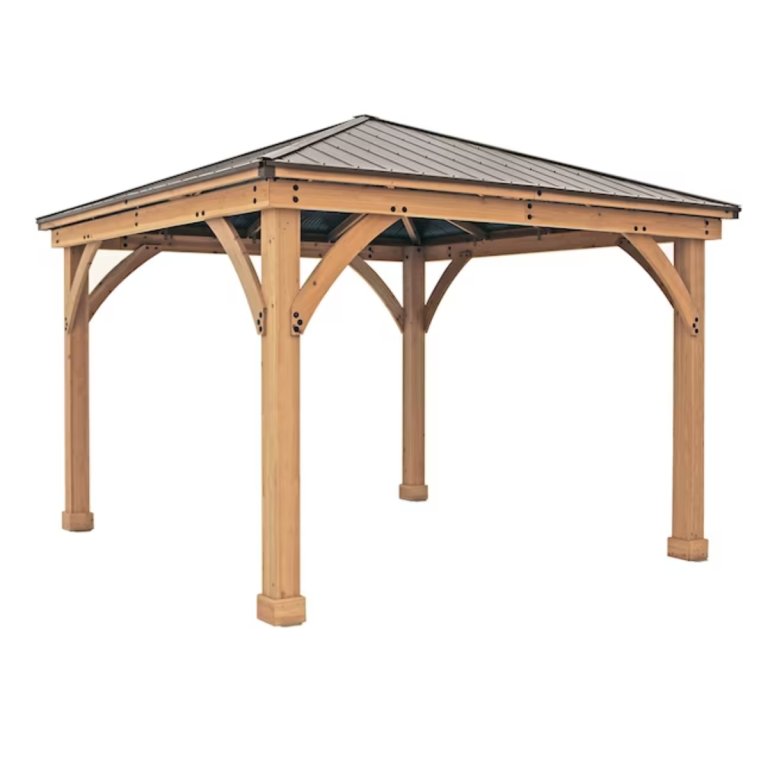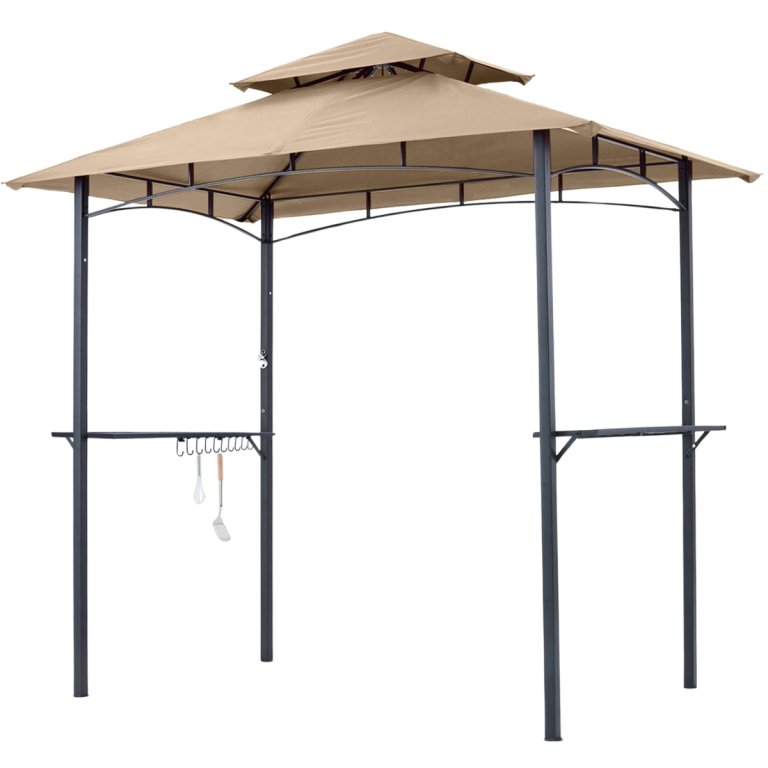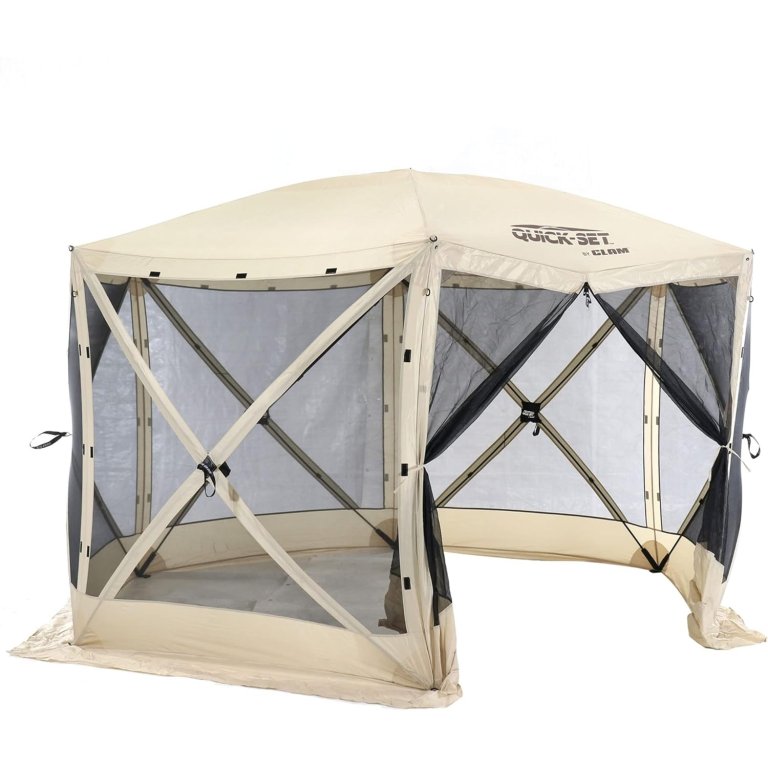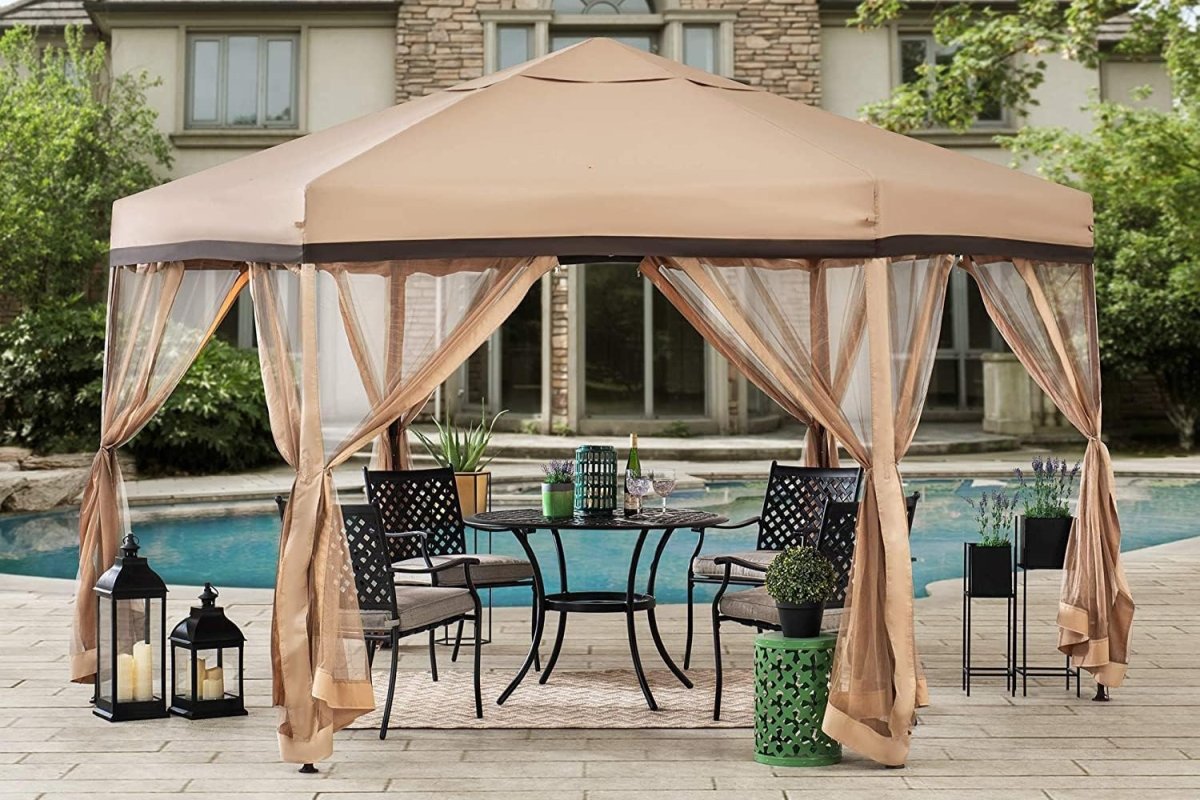
We may earn revenue from the products available on this page and participate in affiliate programs. Learn More ›
A gazebo can be a luxurious addition to a backyard, garden, deck, patio, or porch. Like pergolas and shade sails, these quaint open-air shelters provide protection from the sun, rain, wind, and even pesky insects, creating a comfortable outdoor living space. However, since they range in price between the hundreds and thousands, can be made of many different materials, and come in a variety of sizes, it’s not always easy to know which prefab gazebo is right for your needs.
To help you decide, we researched dozens of gazebos and reached out to an industry expert for their opinion. Based on our efforts, we chose the Kozyard Alexander Hardtop Steel & Aluminum Gazebo as the best overall gazebo for its durable build, integrated gutters, and included insect netting and privacy curtains. Still, other options we researched and tested might be better for your space, so read on to learn more about the best gazebos available and the features that matter most when selecting one.
- BEST OVERALL: Kozyard Alexander Hardtop Steel & Aluminum Gazebo
↓ Jump to Review - BEST BANG FOR THE BUCK: Coos Bay Pop-Up Gazebo With Netting
↓ Jump to Review - UPGRADE PICK: Backyard Discovery Arlington Gazebo w/Electric
↓ Jump to Review - BEST ALL-SEASON: Yardistry 12′ by 12′ Meridian Gazebo
↓ Jump to Review - BEST FOR GRILLING: MasterCanopy 8′ by 5′ Grill Gazebo With LED Lights
↓ Jump to Review - BEST POP-UP: Clam Quick-Set Escape Screen Tent
↓ Jump to Review - ALSO CONSIDER: Erommy Gazebo With Polycarbonate Double Roof
↓ Jump to Review
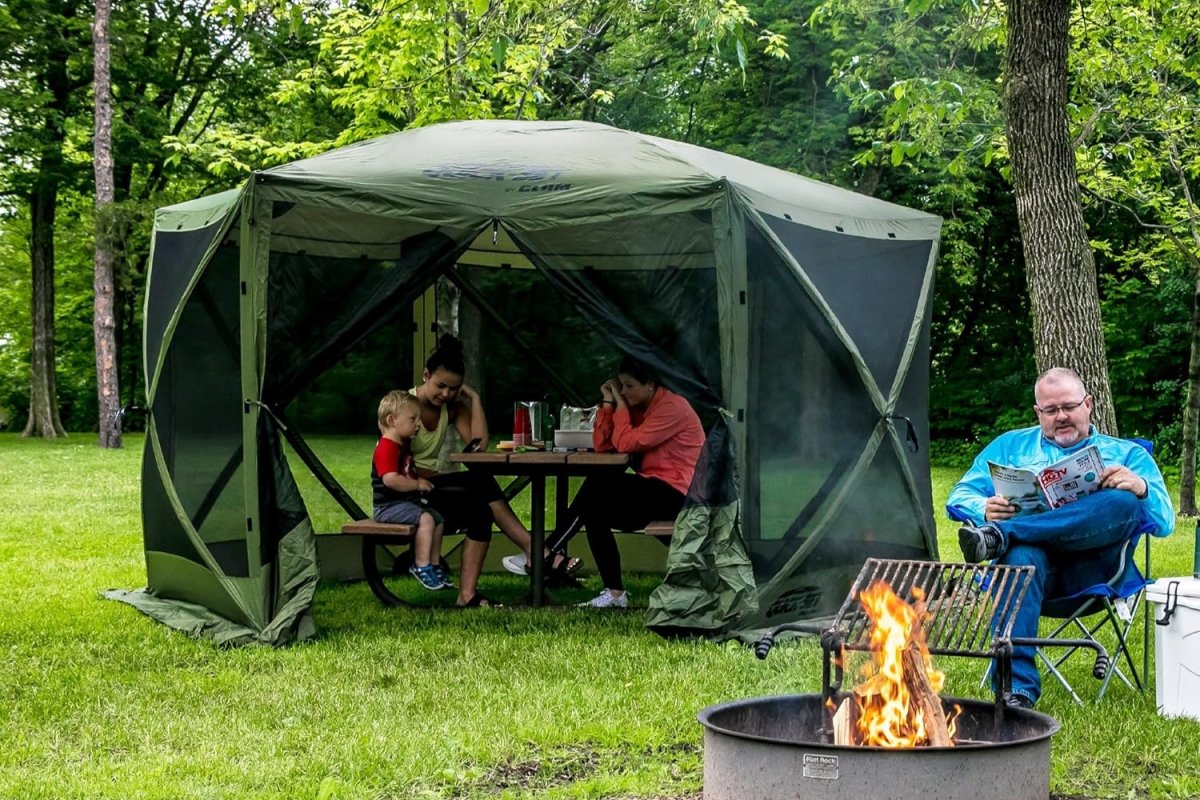
Before You Buy a Gazebo
The best gazebos for patios, gardens, and backyards are sturdy, protective, and aesthetically pleasing. Whether you’re installing a wooden gazebo, a metal gazebo, or a temporary canopy gazebo with sides, planning is an essential part of the process. Start by considering where you’ll place your gazebo and whether the gazebo plans call for additional tools for assembly. Measure the intended installation area to ensure you have plenty of flat ground that’s free of roots, rocks, and other debris.
Depending on where you’d like to place your gazebo, you may need to build a floor if the option you choose doesn’t have one (most don’t). Consider how large a floor will fit and how you’ll anchor the gazebo to it. Bolts, screws, or strap systems are suitable for concrete floors, foundations, and decks, while ground stakes will work in grass or dirt.
Before you bring your backyard landscaping idea to life, it’s a good idea to double-check whether your homeowners’ association or other local governing bodies require permission or a permit. While this isn’t generally necessary for small structures like gazebos and pergolas, it is possible.
In short, follow these steps before buying a gazebo:
- Choose the gazebo location, verifying there’s enough space for your desired gazebo.
- Remember that many popular gazebos don’t include floors, and consider the necessary planning if the floor needs to be built or installed separately.
- Consider anchoring options to ensure safe installation.
- Check to see if you need a permit or permission.
Gazebo Comparison
| Product | Size | Shape | Material |
|---|---|---|---|
| Kozyard Alexander Hardtop Steel & Aluminum Gazebo | 12 feet long by 10 feet wide by 9.6 feet high | Rectangular | Galvanized steel and aluminum |
| Coos Bay Pop-Up Gazebo With Netting | 11 feet long by 11 feet wide by 9.7 feet high | Square | Powder-coated steel and polyester |
| Backyard Discovery Arlington Gazebo w/Electric | 10 feet long by 12.08 feet wide by 10.08 feet high | Rectangular | Wood and steel |
| Yardistry 12′ by 12′ Meridian Gazebo | 12 feet long by 12 feet wide by 10.25 feet high | Square | Wood and aluminum |
| MasterCanopy 8′ by 5′ Grill Gazebo With LED Lights | 8 feet long by 5 feet wide by 8.3 feet high | Rectangular | Steel and polyester |
| Clam Quick-Set Escape Screen Tent | 11.5 feet long by 11.5 feet wide by 7.5 feet high | Hexagonal | Polyester |
| Erommy Gazebo With Polycarbonate Double Roof | 13.1 feet long by 10 feet wide by 9.1 feet high | Rectangular | Aluminum and plastic |
Our Top Picks
A well-designed gazebo can not only provide ample space for backyard relaxation, but it can even increase your property value. The outdoor gazebos that made our list of top picks are durable, protective, and stylish, providing an enjoyable outdoor shelter for years to come.
Best Overall
Kozyard Alexander Hardtop Steel & Aluminum Gazebo
What We Like
- Designed to withstand all seasons
- Gutters direct rain runoff
- Includes mosquito netting and privacy curtains
What We Don’t Like
- May leak due to vented roof design
Specs
- Size: 12 feet long by 10 feet wide by 9.6 feet high
- Shape: Rectangular
- Material: Galvanized steel and aluminum
Made for permanent installation, this hardtop gazebo from Kozyard has a sturdy design with a rustproof aluminum frame and galvanized steel roof. Meant to withstand all types of weather events, including precipitation and wind, this gazebo with shade stands tall in winds up to 40 miles per hour (mph) and holds snowfalls of up to 2,500 pounds. The galvanized steel roof has a vented double-roof design that enables airflow, and the gutter system ensures proper water runoff on rainy days.
With its 12-foot-long by 10-foot-wide size, this contemporary gazebo is perfect for covering large outdoor seating areas year-round. It even comes with double-layered privacy and mosquito-netting curtains, protecting against sun during the day and insects at night.
Get the Kozyard gazebo at Amazon, Lowe’s, The Home Depot, Bed Bath & Beyond, or Kozyard.
Best Bang For The Buck
Coos Bay Pop-Up Gazebo With Netting
What We Like
- Easy to transport and set up
- Comes with a carrying case
- Comfortably covers up to 6 people
- UV- and water-resistant canopy material
What We Don’t Like
- Not made for heavy winds
Specs
- Size: 11 feet long by 11 feet wide by 9.7 feet high
- Shape: Square
- Material: Powder-coated steel and polyester
If you’re looking for a stylish yet affordable gazebo, this Coos Bay outdoor gazebo canopy might be a perfect fit. Essentially a pop-up gazebo, it’s incredibly easy to set up and provides 121 square feet of shade and protection, making it ideal for backyard gatherings, camping trips, or outdoor events.
Setting this canopy gazebo up is a breeze: Just open the metal frame and attach the vented top. Its lightweight steel frame and carrying case make it easy to transport, and the 150D oxford fabric top is water resistant and has a UV protection rating of UPF 50+ to help block up to 99 percent of harmful UV rays. It also has mesh side walls that add an extra layer of comfort by keeping bugs out while allowing air in. Whether you need quick shade for a picnic or want a semi-permanent enclosed gazebo in your yard, this lightweight gazebo delivers convenience without compromising on quality.
Get the Coos Bay gazebo at Amazon, Walmart, or Coos Bay.
Upgrade Pick
Backyard Discovery Arlington Gazebo w/Electric
What We Like
- Designed to withstand winds up to 100 mph
- 50 pounds per square foot snow load capacity
- Built-in outlets and USB power ports
What We Don’t Like
- May require professional installation
Specs
- Size: 10 feet long by 12.08 feet wide by 10.08 feet high
- Shape: Rectangular
- Material: Wood and steel
In areas prone to storms and high winds, a retractable awning or simple shade sail won’t be sufficient. Instead, you’ll need a gazebo built to handle harsh weather, and the Backyard Discovery Arlington gazebo is up to the task. Engineered to withstand winds up to 100 miles per hour and snow loads up to 50 pounds per square foot of snow load, it’s made using very sturdy materials. The heavy-duty frame is solid cedar, and the corrosion-resistant roof is steel. The roof is even insulated to reduce heat transfer, helping maintain a comfortable atmosphere year-round.
More than just a durable structure, the Arlington wood gazebo also features several thoughtful design details. In addition to decorative accents that create a refined look, it has built-in power options (three electrical outlets and three USB ports) that make it easy to add lighting or charge devices. The only possible downsides to this pick are its premium price, the need to run electricity to it, and the fact that its installation might be a bit complicated for less-experienced DIYers.
Get the Backyard Discovery gazebo at Amazon, Lowe’s (12 foot by 12 foot), Wayfair, Walmart, or Backyard Discovery.
Best All-Season
Yardistry 12' by 12'-Foot Meridian Gazebo
What We Like
- Snow and wind load capacities exceed industry standards
- Wood frame is precut, predrilled, and prestained
- Includes hardware and most mounting brackets for installation
What We Don’t Like
- Roof color may fade over time
- Installation requires several sets of hands
Specs
- Size: 12 feet long by 12 feet wide by 10.25 feet high
- Shape: Square
- Material: Wood and aluminum
Rain or shine—and nearly any weather in between—the Yardistry Meridian gazebo is built to stand strong in every season, even winter. Measuring 12 feet square, this year-round structure features a 100 percent cedar frame paired with a rustproof aluminum roof for lasting durability. Its solid roof has double-beam supports and heavy-duty gussets for extra stability. While Yardistry doesn’t provide exact snow load or wind ratings, the brand confirms that the gazebo has been snow load and wind tested to exceed industry standards, making it a reliable choice for most climates.
Despite its sturdiness, the Meridian gazebo is thoughtfully designed for easy assembly, with precut, predrilled components and all necessary hardware included. The natural cedar stain finish not only enhances its aesthetic appeal but also ensures long-lasting resistance to the elements.
Get the Yardistry gazebo at Wayfair, The Home Depot, or Yardistry.
Best For Grilling
MasterCanopy 8' by 5' Grill Gazebo With LED Lights
What We Like
- Perfect size and shape to cover a grill
- Roof vent offers ample airflow
- Shelves and hooks hold food and tools
- Frame has 2 battery-powered LED lights
What We Don’t Like
- Can’t withstand heavy rain
- Lightweight metal poles may warp over time
Specs
- Size: 8 feet long by 5 feet wide by 8.3 feet high
- Shape: Rectangular
- Material: Steel and polyester
Gazebos made for grilling are often relatively small and feature handy shelves and hooks for holding plates, grill tools, and food. This 8-by-5-foot small patio gazebo from MasterCanopy creates a well-organized and weather-protected grilling space, making it the perfect choice for summertime barbecues.
Built for durability, this gazebo for small patios features a rustproof steel frame and a weather-resistant, UV-protective polyester canopy. The soft-top roof provides reliable coverage, while each side of the lighted gazebo includes a sturdy steel shelf for prepping food and placing utensils. A row of hanging hooks keeps grilling tools within reach, while a built-in bottle opener ensures you can crack open a cold drink without missing a beat. While grilling continuously under any canopy isn’t recommended, this gazebo’s 8.3-foot height, double-roof design, and ample venting help smoke dissipate effectively, making the activity possible with proper supervision.
Get the MasterCanopy gazebo at Amazon, Wayfair, Walmart, or MasterCanopy.
Best Pop-up
Clam Quick-Set Escape Screen Tent
What We Like
- Protects against rainfall, UV rays, and insects
- Made with 360-degree mesh screens
- Fits over 6 people and a standard picnic table
- Sets up and collapses easily
What We Don’t Like
- Ceiling may feel low for those over 6 feet tall
Specs
- Size: 11.5 feet long by 11.5 feet wide by 7.5 feet high
- Shape: Hexagonal
- Material: Polyester
For those looking for screened gazebo kits that offer quick protection from bugs and the elements, the Clam Quick-Set Escape screen tent is a top choice. Ideal for outdoor events or backyard camping, this pop-up gazebo sets up in about a minute, providing instant shelter from insects, rain, and UV rays with its 360-degree insect mesh screens and durable 210-denier poly-oxford material. When not in use, it conveniently packs into a 72-inch carrying bag for easy storage and transport.
For added versatility, the tent features sidewalls that can be secured over the mesh screens with hook-and-loop closures, offering extra privacy and wind protection. The spacious interior comfortably fits six people and a standard picnic table, making it perfect for family gatherings or barbecues. The only drawback is its low ceiling height, which may require taller individuals to duck slightly when standing.
What our tester says: “We almost couldn’t believe how quickly this model pops up—it literally takes seconds. The fact that all we have to do is spread it out and snap a couple of fiberglass poles into place makes it perfect for camping. The mesh covers all sides to keep bugs out, and adding optional sidewalls (sold separately) gives us privacy and a way to get out of the wind.”—Stacey L. Nash, Product Reviews tester and writer
Get the Clam gazebo at Amazon, Northern Tool + Equipment, Walmart, Target, or Clam.
Also Consider
Erommy Gazebo With Polycarbonate Double Roof
What We Like
- Double-roof design is perfect for grilling
- Enough square footage to cover a table
- Affordable option for mild climates
What We Don’t Like
- Can’t withstand more than 2 inches of snow
Specs
- Size: 13.1 feet long by 10 feet wide by 9.1 feet high
- Shape: Rectangular
- Material: Aluminum and plastic
For a stylish and functional way to cover a long outdoor dining table, the Erommy 13-by-10-foot rectangular hardtop gazebo is an excellent choice. Designed as a permanent structure, it offers reliable shelter for outdoor lunch and dinner gatherings in a variety of weather conditions.
With a sleek, minimalist design, this gazebo features a powder-coated aluminum frame and a polycarbonate roof. The translucent double roof lets air and soft natural light filter in while still providing shade and blocking 99 percent of harmful UV rays. It also has double-layer sidewalls mounted on a smooth double-track system, keeping bugs out and providing a bit of backyard privacy. While sturdy, this gazebo is best suited for mild climates that don’t see winds more than 30 mph or snowfalls greater than 2 inches. I
Get the Erommy gazebo at Amazon, Walmart, or Erommy.
Jump to Our Top Picks
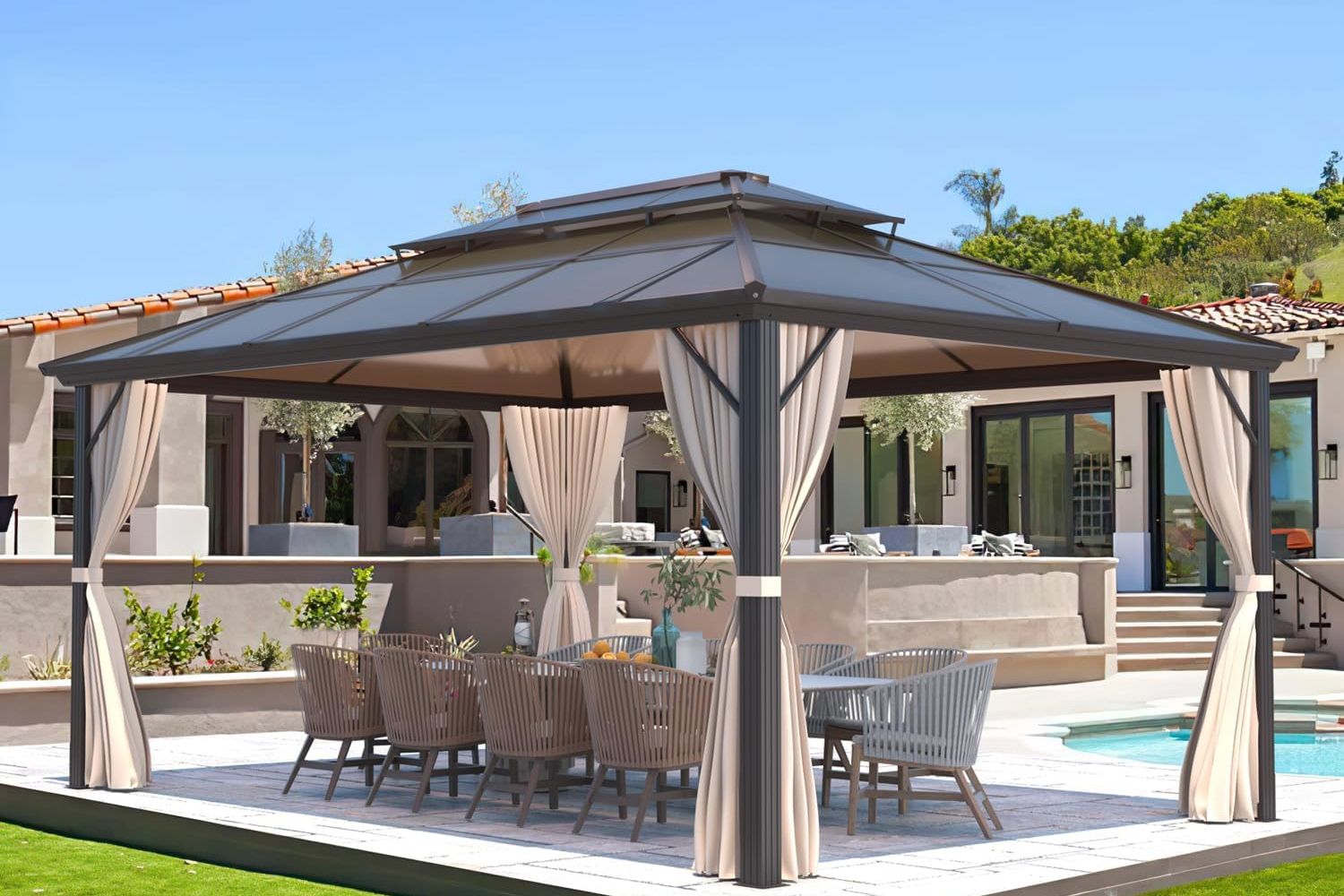
How We Chose the Best Gazebos
The best outdoor gazebos create inviting spaces for everything from alfresco family dinners to private hot tub retreats. Choosing the right gazebo starts with considering its intended use. Durability is key for permanent gazebos for backyards, so look for an option with a sturdy frame and hard roof to ensure it can withstand rain, wind, and snow. If you want to take your gazebo to the beach or camping, a portable pick may be better, so we included several pop-up options. Though not built for harsh weather, they are water resistant and great for protecting against the sun and bugs.
In addition to durability and intended use, we chose the gazebos for this guide based on size. Small groups may fit nicely in a pick at least 10 feet long by 10 feet wide, but those hoping to share the space with larger groups will want something bigger. Finally, we also made sure to include gazebos with extra features while still being relatively easy to set up.
What to Consider When Choosing a Gazebo
When picking the best gazebo for your space, consider its design, size, materials, durability, and installation process.
Size and Shape
When choosing a gazebo, it’s important to find a size that fits your yard or patio without overwhelming the space. At the same time, it should be large enough for its intended use—whether that’s seating a few friends or accommodating a full dining setup for extra outdoor living space during the warmer months. A gazebo for a small patio could be as compact as 6 feet across, whereas larger models might be up to 20 feet long by 12 feet wide. Generally speaking, pop-up gazebos are smaller than permanent structures.
Shape is another key factor. Gazebos can be hexagonal, octagonal, round, square, or rectangular, each suited to different uses. Round and square models are typically small to medium-sized, making them ideal for patio sets, seating areas, or hot tubs. Rectangular gazebos often offer enough coverage for long outdoor dining tables or larger gatherings. Hexagonal and octagonal gazebos may have a more traditional look, but square and rectangular options are generally more commonly available as DIY gazebo kits.
Material and Style
Gazebos come in a range of styles, built from different materials to enable a variety of uses. These materials are either naturally weather-resistant or treated to be waterproof and fade-resistant, ensuring durability while maintaining an attractive look.
Frame material is one of the most important factors to consider, says Stacy Elmore, co-founder of The Luxury Pergola. “Be prepared to repaint or refinish a [wooden] gazebo about every year or two, depending on where you are located,” she advises. Elmore also notes that steel is exceptionally strong and heavy but may rust, while aluminum offers similar strength without rust issues—making it worth the added cost.
Hardtop gazebos feature hard roofs made of wood, metal, or polycarbonate shingles or panels. Soft-top gazebos have canopies made of weather-resistant and tear-resistant materials like polyester or polyethylene, or acrylic materials like the brand Sunbrella. Even soft-top gazebos may be okay for year-round use, provided the manufacturer tested them for inclement weather and heavy winds or designed the canopy to be removed during the offseason.
Pop-up and portable gazebos offer easy assembly, transport, and storage. These soft-top designs typically feature lightweight, foldable frames made from powder-coated or galvanized steel, making them ideal for poolside lounging, backyard barbecues, or outdoor events. However, due to their lighter materials, they may not be suitable for high-wind areas.
Additional Coverage
Gazebos can include a range of features to make them more pleasant to use. Insect netting, curtains, and double-roof designs offer comfort and protection.
Built-in mosquito netting protects from mosquitoes, moths, and other bugs without blocking the view or the breeze. Curtains help block elements like rain and UV rays as well as bugs. Plus, they can also turn the gazebo into a private space. Keep in mind that extras like curtains or netting may need to be taken down during or after wet or windy weather to prevent damage, dampness, or mildewing.
Double-roof designs improve airflow without compromising protection. These roofs have a small gap at the top, allowing fresh air to circulate while an overlapping second layer shields the interior from rain and snow.
Stability and Construction
Stability is a key safety factor when choosing a gazebo. While all gazebos are built for outdoor use, some are sturdier than others. Hardtop, permanent structures offer the most stability, whereas pop-up gazebos designed for easy mobility tend to be the least stable. Soft-top models fall somewhere in the middle, often built to be left up longer than pop-up picks, though it may be best to take their roofs down during inclement weather.
Installation and design features can also impact a gazebo’s stability. Air vents allow wind to pass through, reducing strain on the roof or canopy. Built-in gutters and sloped designs direct water runoff, preventing pooling. Securely spiking, bolting, or staking whichever model you choose firmly to the ground also helps ensure it’s as stable as possible.
Type of Assembly
Gazebos are available as installable, permanent structures or as portable pop-up canopies. Permanent options often take longer to set up but also last much longer. Many DIY installation options include ready-to-install kits with precut and predrilled pieces for easy assembly. Consider installation difficulty and available help—while many of these sets are made for home installers, they will take two or more people to put together. Consider hiring a professional installer if needed.
Pop-up gazebos are easy to assemble and disassemble. They usually have a metal frame that pulls apart or clicks into place and a soft canopy that straps over the top. Some options include storage bags for portability.
FAQs
Whether you need a temporary gazebo for a summer party or a permanent structure for year-round use, there’s a stylish option for most outdoor spaces. Keep these common questions and answers in mind while searching for the best gazebo for your patio or backyard.
It depends on the gazebo type. A good portable pop-up gazebo should last several years, provided it’s used in calm weather. Permanent structures can last much longer, perhaps decades, with proper maintenance.
Generally speaking, permanent hard-top gazebos are best in heavy winds. We recommend you check the manufacturer’s specifications if severe weather conditions are a concern.
Permanent gazebos can stay up year-round since they’re sturdy, have hard roofs, and are anchored to flooring. Soft-top options may be able to stay up all year, but it’s a good idea to follow the manufacturer’s directions regarding your specific model, as you may need to take the canopy down. Portable pop-up gazebos are not meant to be left up year-round.
As with pergola kits, whether or not you need a building permit depends on your jurisdiction and the intended structure type and size. Temporary pop-up gazebos do not require a permit. Most permanent gazebos don’t require a permit either, but it is always a good idea to make sure yours meets the requirements of your local township or homeowners’ association.
Permanent gazebos are typically anchored to the ground, a concrete foundation, a wooden deck, or other fixed flooring using screws, straps, bolts, or similar anchoring systems. Pop-up gazebos usually include stakes to secure the posts into the ground.
Since they are outdoor structures, most gazebos are waterproof. They use weather-resistant or treated materials to withstand wet conditions. Still, it’s a good idea to check the manufacturer’s directions if your area gets a lot of precipitation, especially since soft-top and pop-up canopies might not be built for extended use in wet weather.
